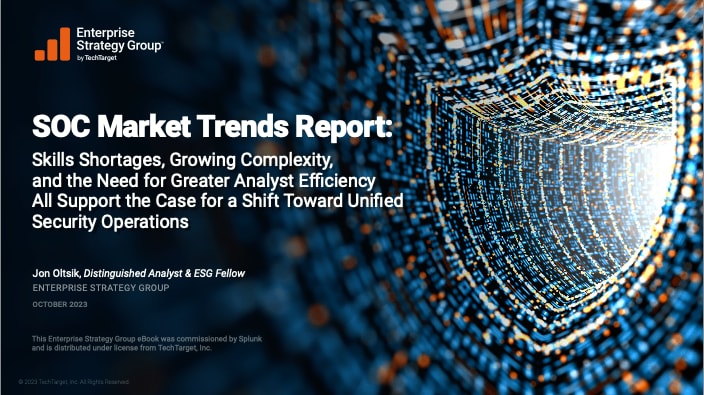Data Federation Brings SOC Teams Up to Attack Speed

When it comes to movie or book characters, complexity can be a welcome element that introduces excitement and mystique to enhance the plot. However, the same does not hold true in your data environment.
In Splunk’s recent “New Rules of Data Management” report, 67% of survey respondents cited data volumes and growth as a top challenge to data management, surpassed only by the 69% who called maintaining data security and compliance their top obstacle. It’s clear that for many — if not most — organizations, the massive increase of data and proliferation of data silos has paved the way for complexity. This makes it increasingly difficult to access, analyze, and secure data, as well as comply with regulatory mandates.
It’s especially frustrating for SOC professionals, charged with keeping the organization’s most prized information safe and protected from malicious threats. Data complexity amplifies an organization's attack surface, providing a shield for bad actors engaging in nefarious activities, while creating other risks that can put the organization in harm’s way. At the same time, SOC analysts regularly face a barrage of alerts with not enough time, staff, or expertise to address them. Neither is a winning scenario.
However, a data federation strategy might be the antidote to the combination of data chaos and the SOC’s staffing shortages that aren’t going away anytime soon. In the following article, we articulate the data complexity problem in the SOC, the benefits of a federation strategy, and how SOC analysts actively employing a federated strategy are consistently driving stronger results.

Resilience starts with strategy
Dispersed data is keeping SOC teams down
Data complexity is a daily reality in the SOC, thanks in part to a growing number of data sources that include on-prem infrastructure, cloud applications, IoT devices, and AI implementations.
SOC teams know all too well that the more heterogeneous the environment, the more challenging it is for them to manage and secure. This is largely because in distributed data landscapes, people are looking at different portions of data, but never at the same picture. One of the biggest downsides to a highly distributed security environment is that a lot of data goes unmanaged — often for a long time. That means it doesn’t get cleaned, stored in optimal locations, or destroyed in a timely manner after its use. Silos emerge as data sources become more varied and diverse, resulting in duplicated and triplicated data, while increasing operational costs, reducing data quality, and creating roadblocks to efficiency.
That all has serious consequences in threat scenarios. Security analysts feel the sting in real time with lack of visibility into the threat landscape, incident alerts that are delayed or missed entirely, and malware that flies in under the radar. In addition to masking critical signals, massive volumes of data can significantly prolong processing times for SOC analysts trying to determine which data is relevant and useful for their security mission and objectives, leading to swivel chair syndrome, alert fatigue, and burnout.
The good news is that there is another way. In fact, for many SOC professionals, data federation may provide some much needed answers.
Learning to thrive with federation
To optimize their limited time, SOC teams need a data strategy that does more than just wrangle and organize data. It also has to make their jobs easier and have a measurable impact on security outcomes — and that’s where data federation comes in.
At its core, data federation enables organizations to see, access, process, and analyze data where it lives within the environment. Organizations have the discretion to determine where their data should reside, whether at the source of creation or other dedicated locations. And that’s a boon for SOC teams — regardless of where the data lives, they have the ability to query and analyze data from a single point, without the need to replicate it, invest in costly migrations, or risk compromising data quality.
In a real-world situation, that means instead of waiting by the phone to learn about an incident, SOC analysts can get the alert from a central point in their data ecosystem. Also, because data federation provides fewer places to store the data, SOC teams have an easier time controlling where data is going. This helps them manage and maintain access control implementation.
The speed and depth of analysis is hands down best with the Splunk platform, which makes it the clear first choice for security teams.
Federation also creates flexibility that enables different teams to benefit from the same data. In addition to leveraging the data for their own analysis, SOC teams can make the results accessible for IT and engineering, opening the door for data sharing and reuse opportunities, as well as fostering organizational collaboration while giving their data more mileage and value.
Data federation drives SOC results
Perhaps not surprisingly, organizations that have adopted fully implemented data federation, along with data pipeline management and data lifecycle management, often have a big leg up when it comes to critical KPIs and other security metrics. They report a 13% higher net operating profit margin, 20% greater sustainability, and 11% faster innovation compared to their peers. Dubbed “data leaders” according to “The New Rules of Data Management” report, security teams applying these practices also reap a host of rewards in the SOC.
These rewards include benefits in key areas of TDIR, like faster threat detection, investigations, and response. Data leaders also report faster MTTR, more successful threat neutralizations, quicker root cause identification, and fewer breaches.
Meanwhile, those that have employed any form of federation, whether partially or fully, still realize a slew of results. For example, 67% of organizations with a federated data management strategy report faster data access, while 54% report improved data governance, and 47% report improved compliance posture. Teams throughout an organization, including the SOC, see measurable increases in data-related metrics, such as speed to access, speed of overall data processing, and a reduced amount of computational overhead.
Organizations that have adopted data federation, whether fully or partially, reveal a slew of benefits, including faster data access (67%), improved data governance (54%), and improved compliance posture (47%).
For security professionals, the transformation won’t happen overnight. Beginning the process likely will require a mentality shift from rigidly holding onto security data to a culture of collaboration and information sharing. But even initial data federation metrics indicate that teams can start slowly — incrementally expanding their data federation strategy while still realizing net positive results. And as SOC teams start laying the groundwork for an effective federation strategy, they’re also building a strong foundation of resilience that will take their data management practices to the next level and help their business thrive.
To learn more about how a data federation strategy can set security and observability teams up for success, download a copy of “The New Rules of Data Management” report.
Related Articles
About Splunk
The world’s leading organizations rely on Splunk, a Cisco company, to continuously strengthen digital resilience with our unified security and observability platform, powered by industry-leading AI.
Our customers trust Splunk’s award-winning security and observability solutions to secure and improve the reliability of their complex digital environments, at any scale.


